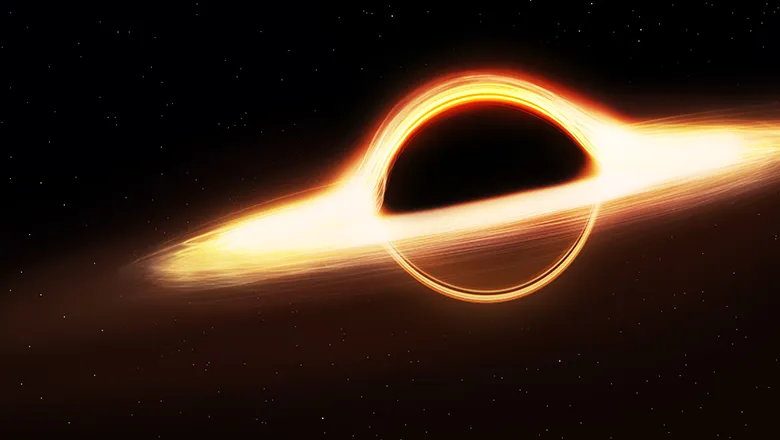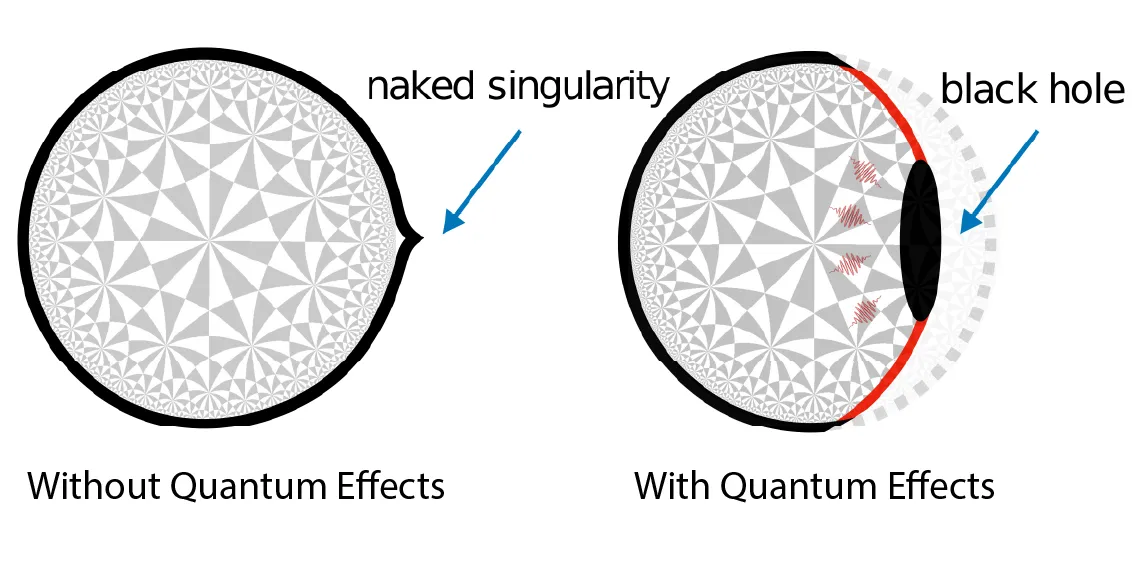Penrose further conjectured that all such singularities must lie behind the event horizon,...this should come as a comforting realisation given it would otherwise mean we’d bear witness to the breakdown of physics.”
Andrew Svesko
21 November 2024
New model advances our understanding of quantum black holes
Scientists have found strong evidence that when quantum effects are taken into account, singularities inside black holes will always be hidden

A team of researchers have significantly advanced our understanding of quantum black holes and their properties. Their new mathematical model provides evidence that when quantum matter is taken into account, singularities inside a black hole – points of infinite density where the laws of physics break down – will always be hidden.
They hope this model could also advance efforts to understand quantum gravity.
Published in the Physical Review Letters, the model was developed by Dr Andrew Svesko in the Department of Mathematics, King’s College London, and current and former researchers from the University of Barcelona and IFT-Madrid. It provides the mathematical basis to support the cosmic censorship conjecture for quantum black holes in three dimensions – ie that when quantum effects are taken into account, the singularity of a black hole will always be concealed.
Cosmic censorship is a conjecture in classical physics developed by eminent mathematician Roger Penrose. King’s author on the paper, Dr Andrew Svesko said, “A well-known mathematical prediction made by Roger Penrose in 1965, for which he shared the 2020 Nobel Prize, is that black holes which form under the collapse of huge stars – like the ones we observe in our universe – develop a ‘singularity’. Singularities are points in spacetime where our conventional notions of space and time break down.
“Penrose further conjectured that all such singularities must lie behind the event horizon, dubbed the ‘cosmic censorship conjecture’ - this should come as a comforting realisation given it would otherwise mean we’d bear witness to the breakdown of physics.”
Whilst the cosmic censorship conjecture and its mathematical basis, ‘the Penrose inequality’, has not been mathematically proven in classical physics, the team of scientists have provided strong mathematical evidence for a notion of quantum cosmic censorship.
Andrew Svesko said, “whilst models had previously been developed in 4D settings and upwards, the testing and evidence was limited. We tested it in 3D and found robust evidence that holds for all known examples of quantum black holes. We hope this theory might also work in four dimensions and higher.”
Quantum black holes are theoretical concepts, rather than classical black holes that exist in outer space following the collapse of stars. Taking into account their theoretical behaviour, the scientists used a method called gravitational holography to test mathematically the effects of quantum matter on singularities and whether censorship would shield them from view.

Dr Svesko explains, “in classical physics there are examples of spacetime geometries which have naked singularities, but if you take the laws that operate at a quantum level and put quantum matter in the background, a horizon develops in the spacetime that encases the previously naked singularity. Turn quantum effects off, the horizon disappears revealing a naked singularity.
“This process – quantum effects modifying the initial classical geometry to clothe a singularity – intuitively captures the spirit of cosmic censorship, but it is solely a quantum effect. And so it is dubbed ‘quantum’ cosmic censorship.”
By proving this notion of the effects of quantum matter on black holes in spacetime, the team believe this could advance efforts to solve quantum gravity, viewed by many scientists as a unification theory for physics.
Andrew Svesko said, “for decades scientists have been searching for a model that incorporates both classical gravity and matter at the quantum scale, ie ‘quantum gravity’.
Resolving black hole singularities continues to be a chief goal for quantum gravity, thus rigorously understanding how notions like cosmic censorship and the Penrose inequality behave when quantum matter effects are accounted for, adds to the list of criteria that can be used to further develop quantum gravity.”
Andrew Svesko
“Resolving black hole singularities continues to be a chief goal for quantum gravity, thus rigorously understanding how notions like cosmic censorship and the Penrose inequality behave when quantum matter effects are accounted for, adds to the list of criteria that can be used to further develop quantum gravity.”
Dr Antonia Frassino, researcher from the Institute of Cosmos Sciences, University of Barcelona and co-author of the work, said “blending gravitation with quantum mechanics has been the holy grail of high energy theoretical physics for many decades. We are now extending well-understood concepts and results in classical gravity to incorporate quantum effects, providing a stepping stone for the new developments in the field.”
The scientists hope their model could even provide a firm benchmark to test models of quantum gravity against, or refine those currently being proposed.
In addition to its work on quantum cosmic censorship, the paper also presents strong evidence for a limit to how much entropy, which measures disorder or randomness, a black hole can have when quantum effects are considered. The new rule called the quantum Reverse Isoperimetric Inequality, extends a classical rule about black hole entropy to apply it to quantum matter as well, furthering our understanding of the thermodynamic properties of black holes.
The study was conducted by Dr Andrew Svesko, King’s College London, Drs Antonia Frassino and Robie Hennigar from the University of Barcelona, and Dr Juan Pedraza from the Instituto de Física Teórica UAM/CSIC. The work was supported by various grants and funding bodies, including the Spanish Ministry of Science and Innovation and the European Union’s Horizon 2020 programme.

